名词解释和问答题
- 格式:doc
- 大小:88.50 KB
- 文档页数:8
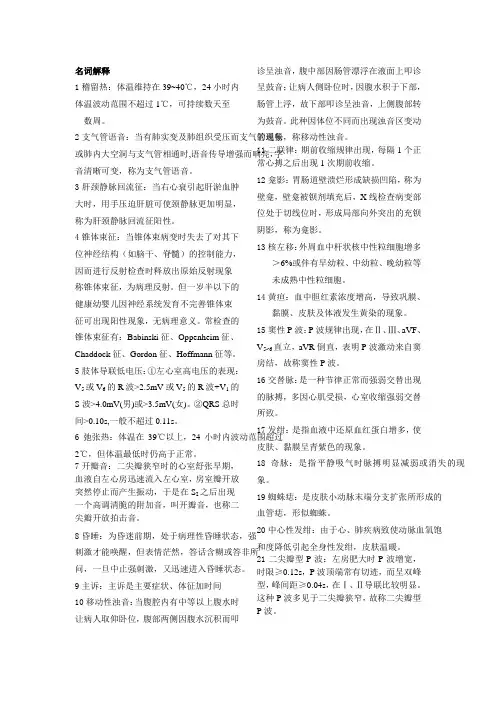
名词解释1稽留热:体温维持在39~40℃,24小时内体温波动范围不超过1℃,可持续数天至 数周。
2支气管语音:当有肺实变及肺组织受压而支气管通畅或肺内大空洞与支气管相通时,语音传导增强而响亮,字音清晰可变,称为支气管语音。
3肝颈静脉回流征:当右心衰引起肝淤血肿大时,用手压迫肝脏可使颈静脉更加明显,称为肝颈静脉回流征阳性。
4锥体束征:当锥体束病变时失去了对其下位神经结构(如脑干、脊髓)的控制能力,因而进行反射检查时释放出原始反射现象称锥体束征,为病理反射。
但一岁半以下的健康幼婴儿因神经系统发育不完善锥体束征可出现阳性现象,无病理意义。
常检查的锥体束征有:Babinski 征、Oppenheim 征、Chaddock 征、Gordon 征、Hoffmann 征等。
5肢体导联低电压:①左心室高电压的表现:V 5或V 6的R 波>2.5mV 或V 5的R 波+V 1的S 波>4.0mV(男)或>3.5mV(女)。
②QRS 总时间>0.10s,一般不超过0.11s 。
6弛张热:体温在39℃以上,24小时内波动范围超过2℃,但体温最低时仍高于正常。
7开瓣音:二尖瓣狭窄时的心室舒张早期,血液自左心房迅速流入左心室,房室瓣开放突然停止而产生振动,于是在S 2之后出现一个高调清脆的附加音,叫开瓣音,也称二尖瓣开放拍击音。
8昏睡:为昏迷前期,处于病理性昏睡状态,强刺激才能唤醒,但表情茫然,答话含糊或答非所问,一旦中止强刺激,又迅速进入昏睡状态。
9主诉:主诉是主要症状、体征加时间10移动性浊音:当腹腔内有中等以上腹水时让病人取仰卧位,腹部两侧因腹水沉积而叩诊呈浊音,腹中部因肠管漂浮在液面上叩诊呈鼓音;让病人侧卧位时,因腹水积于下部,肠管上浮,故下部叩诊呈浊音,上侧腹部转为鼓音。
此种因体位不同而出现浊音区变动的现象,称移动性浊音。
11二联律:期前收缩规律出现,每隔1个正常心搏之后出现1次期前收缩。
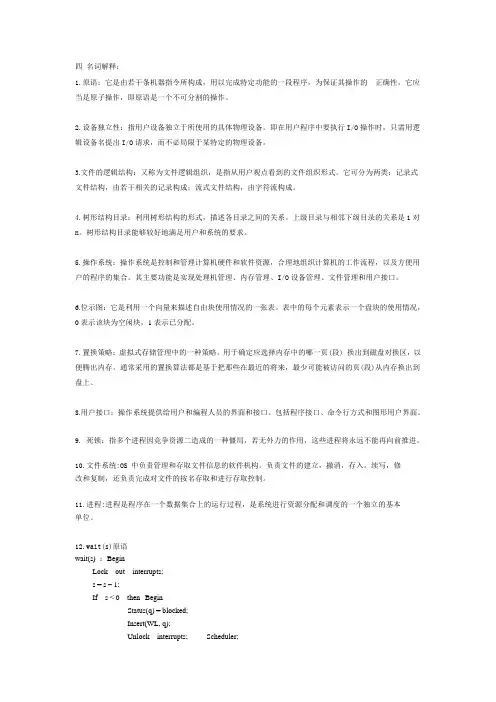
四名词解释:1.原语:它是由若干条机器指令所构成,用以完成特定功能的一段程序,为保证其操作的正确性,它应当是原子操作,即原语是一个不可分割的操作。
2.设备独立性:指用户设备独立于所使用的具体物理设备。
即在用户程序中要执行I/O操作时,只需用逻辑设备名提出I/O请求,而不必局限于某特定的物理设备。
3.文件的逻辑结构:又称为文件逻辑组织,是指从用户观点看到的文件组织形式。
它可分为两类:记录式文件结构,由若干相关的记录构成;流式文件结构,由字符流构成。
4.树形结构目录:利用树形结构的形式,描述各目录之间的关系。
上级目录与相邻下级目录的关系是1对n。
树形结构目录能够较好地满足用户和系统的要求。
5.操作系统:操作系统是控制和管理计算机硬件和软件资源,合理地组织计算机的工作流程,以及方便用户的程序的集合。
其主要功能是实现处理机管理、内存管理、I/O设备管理、文件管理和用户接口。
6.位示图:它是利用一个向量来描述自由块使用情况的一张表。
表中的每个元素表示一个盘块的使用情况,0表示该块为空闲块,1表示已分配。
7.置换策略:虚拟式存储管理中的一种策略。
用于确定应选择内存中的哪一页(段) 换出到磁盘对换区,以便腾出内存。
通常采用的置换算法都是基于把那些在最近的将来,最少可能被访问的页(段)从内存换出到盘上。
8.用户接口:操作系统提供给用户和编程人员的界面和接口。
包括程序接口、命令行方式和图形用户界面。
9.死锁:指多个进程因竞争资源二造成的一种僵局,若无外力的作用,这些进程将永远不能再向前推进。
10.文件系统:OS中负责管理和存取文件信息的软件机构。
负责文件的建立,撤消,存入,续写,修改和复制,还负责完成对文件的按名存取和进行存取控制。
11.进程:进程是程序在一个数据集合上的运行过程,是系统进行资源分配和调度的一个独立的基本单位。
12.wait(s)原语wait(s) :BeginLock out interrupts;s = s – 1;If s < 0 then BeginStatus(q) = blocked;Insert(WL, q);Unlock interrupts; Scheduler;EndElse unlock interrupts;End13.链接文件逻辑文件中的不同记录可以存储在离散的磁盘块中。
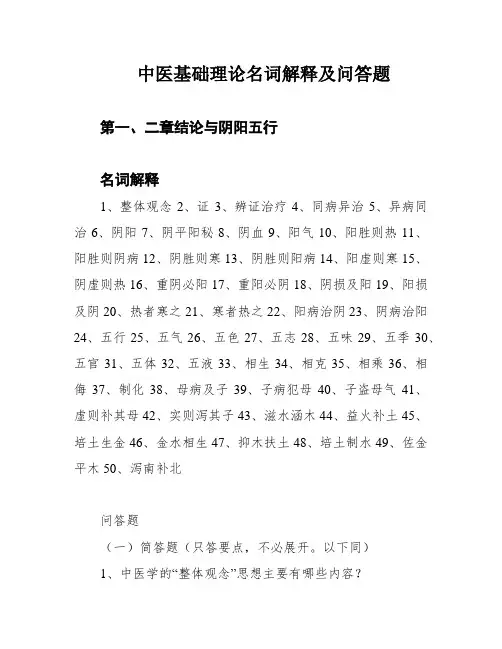
中医基础理论名词解释及问答题第一、二章结论与阴阳五行名词解释1、整体观念2、证3、辨证治疗4、同病异治5、异病同治6、阴阳7、阴平阳秘8、阴血9、阳气10、阳胜则热11、阳胜则阴病12、阴胜则寒13、阴胜则阳病14、阳虚则寒15、阴虚则热16、重阴必阳17、重阳必阴18、阴损及阳19、阳损及阴20、热者寒之21、寒者热之22、阳病治阴23、阴病治阳24、五行25、五气26、五色27、五志28、五味29、五季30、五官31、五体32、五液33、相生34、相克35、相乘36、相侮37、制化38、母病及子39、子病犯母40、子盗母气41、虚则补其母42、实则泻其子43、滋水涵木44、益火补土45、培土生金46、金水相生47、抑木扶土48、培土制水49、佐金平木50、泻南补北问答题(一)简答题(只答要点,不必展开。
以下同)1、中医学的“整体观念”思想主要有哪些内容?2、什么是中医学的辨证论治?3、简述阴阳五行学说的中心思想。
4、简述阴阳学说的基本内容。
5、怎样理解“阴在内,阳之地也;阳在外,阴之使也”?6、怎样理解“阳病治阴,阴病治阳”?7、既然五脏属阴,六腑属阳,为什么又说心肺属阳?8、简述五行的特性。
9、什么叫五行的生克乘侮,其顺序如何?10、五行学说在诊断和治疗上的应用如何?(二)轮述题(除答出要点外,还要求展开论述。
以下同)1、试用阴阳学说说明人体的病理变化?2、阴阳学说如何指导疾病的治疗?3、试用五行学说说明五脏之间的生理接洽。
4、试用五行学说说明五脏之间的病理影响。
第三章藏象名词解释1、藏象2、藏象学说3、脏腑4、五脏5、六腑6、奇恒之府7、神8、血府9、汗血同源10、津血同源11、1肺朝百脉12、肺主治节13、肺主行水14、通调水道15、肺为水之上源16、气门7、肺为娇脏18、肺主宣发和肃降19、脾主运化20、脾胃为后天之本21、肾为先天之本22、先天之精23、后天之精24、天癸25、元阴26、元阳27、肾者,胃之关也28、髓海29、七冲门30、中精之府31、水谷之海32、三焦气化33、心肾相交34、心肾不交35、脾为生痰之源,肺为贮痰之器36、肺为气之主,肾为气之根37、精血同源38、水气凌心。
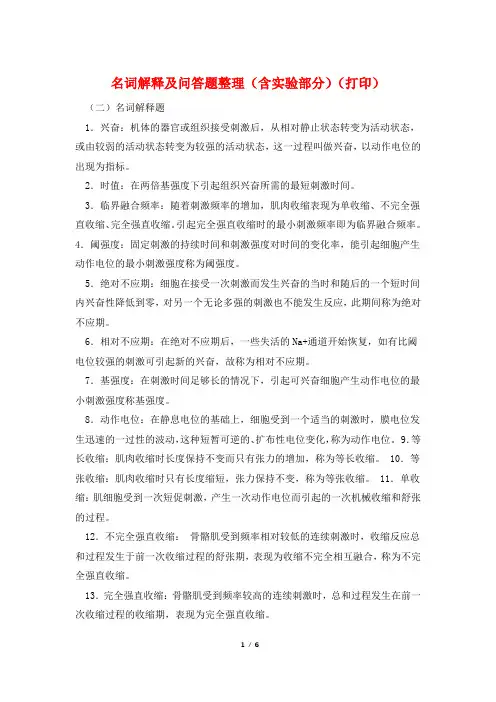
名词解释及问答题整理(含实验部分)(打印)(二)名词解释题1.兴奋:机体的器官或组织接受刺激后,从相对静止状态转变为活动状态,或由较弱的活动状态转变为较强的活动状态,这一过程叫做兴奋,以动作电位的出现为指标。
2.时值:在两倍基强度下引起组织兴奋所需的最短刺激时间。
3.临界融合频率:随着刺激频率的增加,肌肉收缩表现为单收缩、不完全强直收缩、完全强直收缩。
引起完全强直收缩时的最小刺激频率即为临界融合频率。
4.阈强度:固定刺激的持续时间和刺激强度对时间的变化率,能引起细胞产生动作电位的最小刺激强度称为阈强度。
5.绝对不应期:细胞在接受一次刺激而发生兴奋的当时和随后的一个短时间内兴奋性降低到零,对另一个无论多强的刺激也不能发生反应,此期间称为绝对不应期。
6.相对不应期:在绝对不应期后,一些失活的Na+通道开始恢复,如有比阈电位较强的刺激可引起新的兴奋,故称为相对不应期。
7.基强度:在刺激时间足够长的情况下,引起可兴奋细胞产生动作电位的最小刺激强度称基强度。
8.动作电位:在静息电位的基础上,细胞受到一个适当的刺激时,膜电位发生迅速的一过性的波动,这种短暂可逆的、扩布性电位变化,称为动作电位。
9.等长收缩:肌肉收缩时长度保持不变而只有张力的增加,称为等长收缩。
10.等张收缩:肌肉收缩时只有长度缩短,张力保持不变,称为等张收缩。
11.单收缩:肌细胞受到一次短促刺激,产生一次动作电位而引起的一次机械收缩和舒张的过程。
12.不完全强直收缩:骨骼肌受到频率相对较低的连续刺激时,收缩反应总和过程发生于前一次收缩过程的舒张期,表现为收缩不完全相互融合,称为不完全强直收缩。
13.完全强直收缩:骨骼肌受到频率较高的连续刺激时,总和过程发生在前一次收缩过程的收缩期,表现为完全强直收缩。
14.红细胞比容: 抗凝血在比容管内以3000转/min的速度离心30min后血细胞在全血中所占的容积百分比,叫做红细胞比容,又叫红细胞压积。
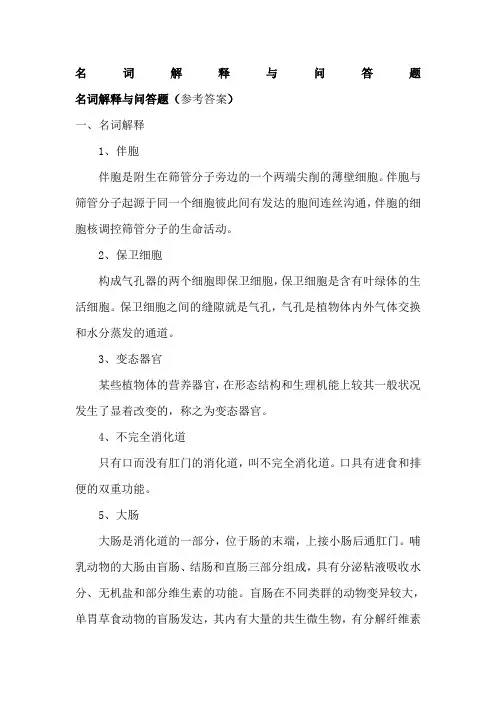
名词解释与问答题名词解释与问答题(参考答案)一、名词解释1、伴胞伴胞是附生在筛管分子旁边的一个两端尖削的薄壁细胞。
伴胞与筛管分子起源于同一个细胞彼此间有发达的胞间连丝沟通,伴胞的细胞核调控筛管分子的生命活动。
2、保卫细胞构成气孔器的两个细胞即保卫细胞,保卫细胞是含有叶绿体的生活细胞。
保卫细胞之间的缝隙就是气孔,气孔是植物体内外气体交换和水分蒸发的通道。
3、变态器官某些植物体的营养器官,在形态结构和生理机能上较其一般状况发生了显着改变的,称之为变态器官。
4、不完全消化道只有口而没有肛门的消化道,叫不完全消化道。
口具有进食和排便的双重功能。
5、大肠大肠是消化道的一部分,位于肠的末端,上接小肠后通肛门。
哺乳动物的大肠由盲肠、结肠和直肠三部分组成,具有分泌粘液吸收水分、无机盐和部分维生素的功能。
盲肠在不同类群的动物变异较大,单胃草食动物的盲肠发达,其内有大量的共生微生物,有分解纤维素的功能。
6、导管由一系列纵向连接的长柱形细胞组成,每个细胞叫导管分子。
成熟的导管分子原生质解体消失,四周的细胞壁木质化不均匀加厚,是死细胞。
分子间的横壁在细胞成熟过程中溶解,因而成为一条连续贯通的管道。
7、非特异性免疫机体生来就有天然的防御能力,对多种病原生物都有一定的防御作用,没有特殊的针对性。
所以,称作非特异性免疫。
非特异性免疫的第一道防线是皮肤和粘膜,第二道防线是体液中的吞噬细胞、溶菌酶等杀菌物质。
8、辐射对称动物体的低等对称形式,过中轴对动物体进行纵切,有无数个切面都可以将动物体分成互为镜像的两部分,这种对称形式即为辐射对称。
例如水螅、水母的身体即为辐射对称。
9、复眼昆虫的视觉器官包括单眼和复眼,复眼由许多单眼组成,有色觉功能可形成彩色的镶嵌图象,对昆虫识别植物花的种类具有重要意义。
10、刚毛环节动物门,寡毛纲动物的运动器官,动物可通过肌肉运动,使刚毛附着和固定在基底物质上,支持身体运动。
11、根尖植物根最前端4~6mm的部位为根尖,它是根生命活动最活跃的地方。
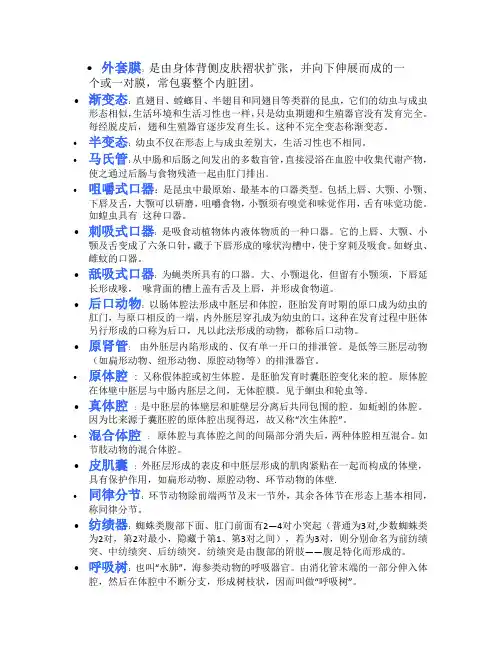
•外套膜:是由身体背侧皮肤褶状扩张,并向下伸展而成的一个或一对膜,常包裹整个内脏团。
•渐变态:直翅目、螳螂目、半翅目和同翅目等类群的昆虫,它们的幼虫与成虫形态相似,生活环境和生活习性也一样,只是幼虫期翅和生殖器官没有发育完全。
每经脱皮后,翅和生殖器官逐步发育生长。
这种不完全变态称渐变态。
•半变态:幼虫不仅在形态上与成虫差别大,生活习性也不相同。
•马氏管:从中肠和后肠之间发出的多数盲管,直接浸浴在血腔中收集代谢产物,使之通过后肠与食物残渣一起由肛门排出。
•咀嚼式口器:是昆虫中最原始、最基本的口器类型。
包括上唇、大颚、小颚、下唇及舌,大颚可以研磨,咀嚼食物,小颚须有嗅觉和味觉作用,舌有味觉功能。
如蝗虫具有这种口器。
•刺吸式口器:是吸食动植物体内液体物质的一种口器。
它的上唇、大颚、小颚及舌变成了六条口针,藏于下唇形成的喙状沟槽中,使于穿刺及吸食。
如蚜虫、雌蚊的口器。
•舐吸式口器:为蝇类所具有的口器。
大、小颚退化,但留有小颚须,下唇延长形成喙,喙背面的槽上盖有舌及上唇,并形成食物道。
•后口动物:以肠体腔法形成中胚层和体腔,胚胎发育时期的原口成为幼虫的肛门,与原口相反的一端,内外胚层穿孔成为幼虫的口,这种在发育过程中胚体另行形成的口称为后口,凡以此法形成的动物,都称后口动物。
•原肾管: 由外胚层内陷形成的、仅有单一开口的排泄管。
是低等三胚层动物(如扁形动物、纽形动物、原腔动物等)的排泄器官。
•原体腔: 又称假体腔或初生体腔。
是胚胎发育时囊胚腔变化来的腔。
原体腔在体壁中胚层与中肠内胚层之间,无体腔膜。
见于蛔虫和轮虫等。
•真体腔: 是中胚层的体壁层和脏壁层分离后共同包围的腔。
如蚯蚓的体腔。
因为比来源于囊胚腔的原体腔出现得迟,故又称“次生体腔”。
•混合体腔: 原体腔与真体腔之间的间隔部分消失后,两种体腔相互混合。
如节肢动物的混合体腔。
•皮肌囊:外胚层形成的表皮和中胚层形成的肌肉紧贴在一起而构成的体壁,具有保护作用,如扁形动物、原腔动物、环节动物的体壁.•同律分节:环节动物除前端两节及末一节外,其余各体节在形态上基本相同,称同律分节。
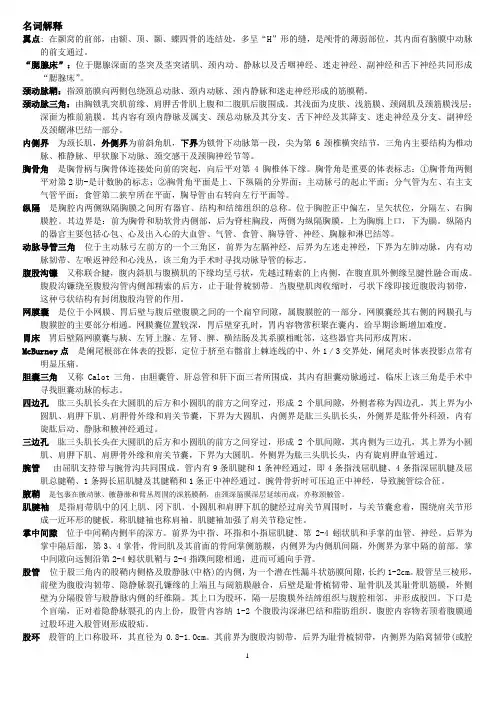
名词解释翼点: 在颞窝的前部,由额、顶、颞、蝶四骨的连结处,多呈“H”形的缝,是颅骨的薄弱部位,其内面有脑膜中动脉的前支通过。
“腮腺床”:位于腮腺深面的茎突及茎突诸肌、颈内动、静脉以及舌咽神经、迷走神经、副神经和舌下神经共同形成“腮腺床”。
颈动脉鞘:指颈筋膜向两侧包绕颈总动脉、颈内动脉、颈内静脉和迷走神经形成的筋膜鞘。
颈动脉三角:由胸锁乳突肌前缘、肩胛舌骨肌上腹和二腹肌后腹围成。
其浅面为皮肤、浅筋膜、颈阔肌及颈筋膜浅层;深面为椎前筋膜。
其内容有颈内静脉及属支、颈总动脉及其分支、舌下神经及其降支、迷走神经及分支、副神经及颈耀淋巴结一部分。
内侧界为颈长肌,外侧界为前斜角肌,下界为锁骨下动脉第一段,尖为第6颈椎横突结节,三角内主要结构为椎动脉、椎静脉、甲状腺下动脉、颈交感干及颈胸神经节等。
胸骨角是胸骨柄与胸骨体连接处向前的突起,向后平对第4胸椎体下缘。
胸骨角是重要的体表标志:①胸骨角两侧平对第2肋-是计数胁的标志;②胸骨角平面是上、下纵隔的分界面;主动脉弓的起止平面;分气管为左、右主支气管平面;食管第二狭窄所在平面,胸导管由右转向左行平面等。
纵隔是胸腔内两侧纵隔胸膜之间所有器官、结构和结缔组织的总称。
位于胸腔正中偏左,呈矢状位,分隔左、右胸膜腔。
其边界是:前为胸骨和肋软骨内侧部,后为脊柱胸段,两侧为纵隔胸膜,上为胸廓上口,下为膈。
纵隔内的器官主要包括心包、心及出入心的大血管、气管、食管、胸导管、神经、胸腺和淋巴结等。
动脉导管三角位于主动脉弓左前方的一个三角区,前界为左膈神经,后界为左迷走神经,下界为左肺动脉,内有动脉韧带、左喉返神经和心浅丛,该三角为手术时寻找动脉导管的标志。
腹股沟镰又称联合腱,腹内斜肌与腹横肌的下缘均呈弓状,先越过精索的上内侧,在腹直肌外侧缘呈腱性融合而成。
腹股沟镰绕至腹股沟管内侧部精索的后方,止于耻骨梳韧带。
当腹壁肌肉收缩时,弓状下缘即接近腹股沟韧带,这种弓状结构有封闭腹股沟管的作用。
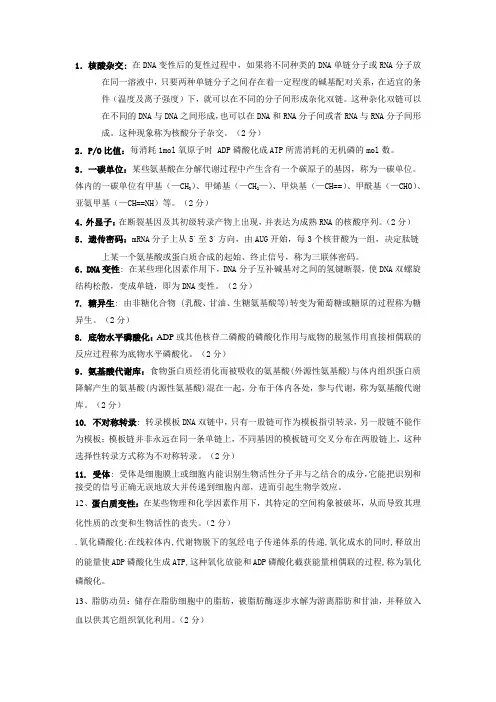
1.核酸杂交: 在DNA变性后的复性过程中,如果将不同种类的DNA单链分子或RNA分子放在同一溶液中,只要两种单链分子之间存在着一定程度的碱基配对关系,在适宜的条件(温度及离子强度)下,就可以在不同的分子间形成杂化双链。
这种杂化双链可以在不同的DNA与DNA之间形成,也可以在DNA和RNA分子间或者RNA与RNA分子间形成。
这种现象称为核酸分子杂交。
(2分)2.P/O比值:每消耗1mol氧原子时 ADP磷酸化成ATP所需消耗的无机磷的mol数。
3.一碳单位:某些氨基酸在分解代谢过程中产生含有一个碳原子的基因,称为一碳单位。
体内的一碳单位有甲基(—CH3)、甲烯基(—CH2—)、甲炔基(—CH==)、甲酰基(—CHO)、亚氨甲基(—CH==NH)等。
(2分)4.外显子:在断裂基因及其初级转录产物上出现,并表达为成熟RNA的核酸序列。
(2分)5.遗传密码:mRNA分子上从5,至3,方向,由AUG开始,每3个核苷酸为一组,决定肽链上某一个氨基酸或蛋白质合成的起始、终止信号,称为三联体密码。
6.DNA变性: 在某些理化因素作用下,DNA分子互补碱基对之间的氢键断裂,使DNA双螺旋结构松散,变成单链,即为DNA变性。
(2分)7. 糖异生: 由非糖化合物 (乳酸、甘油、生糖氨基酸等)转变为葡萄糖或糖原的过程称为糖异生。
(2分)8. 底物水平磷酸化:ADP或其他核苷二磷酸的磷酸化作用与底物的脱氢作用直接相偶联的反应过程称为底物水平磷酸化。
(2分)9.氨基酸代谢库:食物蛋白质经消化而被吸收的氨基酸(外源性氨基酸)与体内组织蛋白质降解产生的氨基酸(内源性氨基酸)混在一起,分布于体内各处,参与代谢,称为氨基酸代谢库。
(2分)10. 不对称转录: 转录模板DNA双链中,只有一股链可作为模板指引转录,另一股链不能作为模板;模板链并非永远在同一条单链上,不同基因的模板链可交叉分布在两股链上,这种选择性转录方式称为不对称转录。
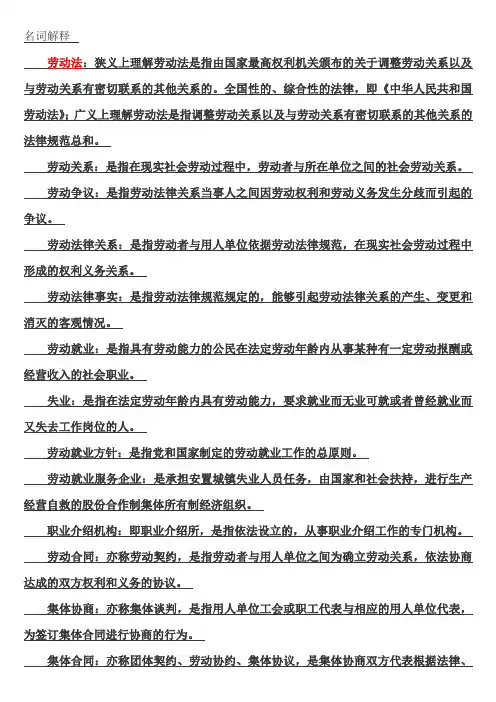
名词解释劳动法:狭义上理解劳动法是指由国家最高权利机关颁布的关于调整劳动关系以及与劳动关系有密切联系的其他关系的。
全国性的、综合性的法律,即《中华人民共和国劳动法》;广义上理解劳动法是指调整劳动关系以及与劳动关系有密切联系的其他关系的法律规范总和。
劳动关系:是指在现实社会劳动过程中,劳动者与所在单位之间的社会劳动关系。
劳动争议:是指劳动法律关系当事人之间因劳动权利和劳动义务发生分歧而引起的争议。
劳动法律关系:是指劳动者与用人单位依据劳动法律规范,在现实社会劳动过程中形成的权利义务关系。
劳动法律事实:是指劳动法律规范规定的,能够引起劳动法律关系的产生、变更和消灭的客观情况。
劳动就业:是指具有劳动能力的公民在法定劳动年龄内从事某种有一定劳动报酬或经营收入的社会职业。
失业:是指在法定劳动年龄内具有劳动能力,要求就业而无业可就或者曾经就业而又失去工作岗位的人。
劳动就业方针:是指党和国家制定的劳动就业工作的总原则。
劳动就业服务企业:是承担安置城镇失业人员任务,由国家和社会扶持,进行生产经营自救的股份合作制集体所有制经济组织。
职业介绍机构:即职业介绍所,是指依法设立的,从事职业介绍工作的专门机构。
劳动合同:亦称劳动契约,是指劳动者与用人单位之间为确立劳动关系,依法协商达成的双方权利和义务的协议。
集体协商:亦称集体谈判,是指用人单位工会或职工代表与相应的用人单位代表,为签订集体合同进行协商的行为。
集体合同:亦称团体契约、劳动协约、集体协议,是集体协商双方代表根据法律、法规的规定就劳动报酬、工作时间、休息休假、劳动安全卫生、保险福利等事项在平等协商一致基础上签订的书面协议。
工资:是指基本劳动关系,用人单位根据劳动者提供的劳动数量和质量,按照劳动合同约定支付的货币报酬。
工资总量:是指用人单位在一定时间内直接支付给本单位劳动者的工资总额。
最低工资:是指用人单位对单位时间劳动必须按法定最低标准支付的工资。
最低工资标准:是指单位劳动时间的最低工资数额。
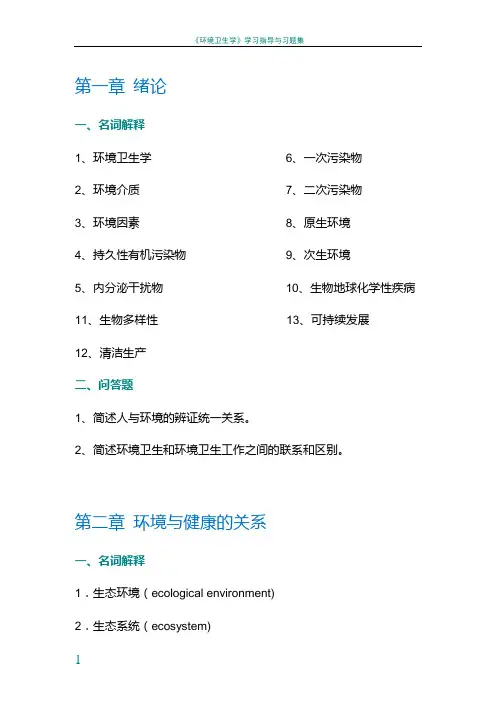
第一章绪论一、名词解释1、环境卫生学6、一次污染物2、环境介质7、二次污染物3、环境因素8、原生环境4、持久性有机污染物9、次生环境5、内分泌干扰物10、生物地球化学性疾病11、生物多样性13、可持续发展12、清洁生产二、问答题1、简述人与环境的辨证统一关系。
2、简述环境卫生和环境卫生工作之间的联系和区别。
第二章环境与健康的关系一、名词解释1.生态环境(ecological environment)2.生态系统(ecosystem)3.生态系统服务(ecosystem service)4.环境与人体的生态平衡5.生物放大作用(biomagnification)6.二次污染物(secondary pollutant)7.一次污染物(primary pollutant)8.剂量-反应关系(dose-response relationship) 9.联合毒性作用(joint toxic effect)10.相加作用(additive effect)11.协同作用(synergistic effect)12.增强作用(potentiation)13.拮抗作用(antagonism)14.健康效应谱(spectrum of health effect)15.易感人群(susceptible group)16.环境应答基因(environmental response gene) 17.必需微量元素(essential trace element)18.生物地球化学性疾病(biogeochemical disease) 19.环境污染(environmental pollution)20.持久性有机污染物(persistent organic pollutants)21.先天畸形(congenital malformation)22.胚胎毒性(embryotoxicity)23.环境内分泌干扰物(environmental endocrine disrupting chemicals)24.内剂量(internal dose)25.生物有效剂量(biologically effective dose)26.高危人群(high risk group)27.生物标志(biomarker)28.健康危险度评价(health risk assessment)29.致癌强度系数(carcinogenic potency factor)二、问答题1.人体对环境的适应在维持人类的生存和健康上有何意义?2.什么是环境物质的迁移和转化作用?环境污染物在环境介质中发生的迁移和转化对环境因素的暴露会产生哪些影响?举例说明。
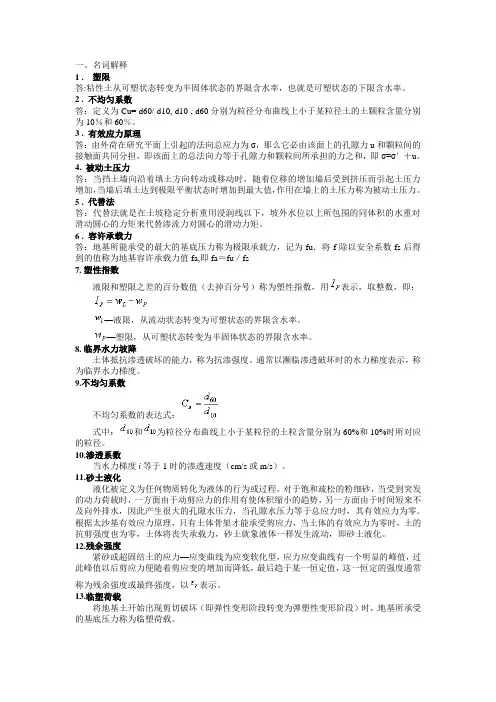
一、名词解释1 . 塑限答:粘性土从可塑状态转变为半固体状态的界限含水率,也就是可塑状态的下限含水率。
2 . 不均匀系数答:定义为Cu= d60/ d10, d10 , d60分别为粒径分布曲线上小于某粒径土的土颗粒含量分别为10%和60%。
3 . 有效应力原理答:由外荷在研究平面上引起的法向总应力为σ,那么它必由该面上的孔隙力u和颗粒间的接触面共同分担,即该面上的总法向力等于孔隙力和颗粒间所承担的力之和,即σ=σ'+u。
4. 被动土压力答:当挡土墙向沿着填土方向转动或移动时,随着位移的增加墙后受到挤压而引起土压力增加,当墙后填土达到极限平衡状态时增加到最大值,作用在墙上的土压力称为被动土压力。
5 . 代替法答:代替法就是在土坡稳定分析重用浸润线以下,坡外水位以上所包围的同体积的水重对滑动圆心的力矩来代替渗流力对圆心的滑动力矩。
6 . 容许承载力答:地基所能承受的最大的基底压力称为极限承载力,记为fu.将f除以安全系数fs后得到的值称为地基容许承载力值fa,即fa=fu/fs7. 塑性指数液限和塑限之差的百分数值(去掉百分号)称为塑性指数,用表示,取整数,即:—液限,从流动状态转变为可塑状态的界限含水率。
—塑限,从可塑状态转变为半固体状态的界限含水率。
8. 临界水力坡降土体抵抗渗透破坏的能力,称为抗渗强度。
通常以濒临渗透破坏时的水力梯度表示,称为临界水力梯度。
9.不均匀系数不均匀系数的表达式:式中:和为粒径分布曲线上小于某粒径的土粒含量分别为60%和10%时所对应的粒径。
10.渗透系数当水力梯度i等于1时的渗透速度(cm/s或m/s)。
11.砂土液化液化被定义为任何物质转化为液体的行为或过程。
对于饱和疏松的粉细砂,当受到突发的动力荷载时,一方面由于动剪应力的作用有使体积缩小的趋势,另一方面由于时间短来不及向外排水,因此产生很大的孔隙水压力,当孔隙水压力等于总应力时,其有效应力为零。
根据太沙基有效应力原理,只有土体骨架才能承受剪应力,当土体的有效应力为零时,土的抗剪强度也为零,土体将丧失承载力,砂土就象液体一样发生流动,即砂土液化。
医学遗传学一名词解释1、遗传:是指生物繁殖过程中,子代与亲代相似的现象,不仅形态外貌上相似,而且在生物体的结构生理和生化特征等方面都相似一保持世代间的延续,保证物种的相对稳定。
2、变异:是指生物世代间延续的过程中子代与亲代,子代个体之间的差异。
3、单基因病:主要受一对基因所控制的疾病,即由一对染色体(同源染色体)上单个基因或一对等位基因发生突变所引起的疾病。
呈孟德尔式遗传。
4、多基因病:由两对以上(多对或若干对)基因和环境因素共同作用所致的疾病。
5、染色体病:或称染色体异常综合征,是指因为染色体数目异常或结构异常所导致的疾病。
6、基因:基因是特定的DNA片段,带有遗传信息,可通过控制细胞内RNA和蛋白质(酶)的合成,进而决定生物的遗传性状。
7、调空基因:调控基因指可调节控制结构基因表达的基因。
8、结构基因:结构基因指可控制结构基因表达的基因。
9、断裂基因:指编码序列不连续,被非编码序列分隔嵌合排列的断裂形式的基因。
如人类的结构基因。
10、基因组:指生物承受生殖细胞(单倍体细胞)DNA分子的全部基因总和。
11、基因表达:指储存在基因中的遗传信息通过转录和翻译,转变成蛋白质或酶分子,形成生物特定性状的过程。
12、转录:转录指以DNA为膜板,在RNA聚合酶作用下合成RNA的过程,13、翻译:翻译指mRNA指导下的蛋白质生物合成过程。
14:基因突变:基因突变指基因的核苷酸序列或数目发生改变。
15:移码突变:是指DNA链上插入或丢失一、两个或多个碱基时,引起变化点下游的碱基发生位移,密码子重新组合,导致变化点以后多肽的氨基酸种类和序列发生改变。
16:整码突变:指DNA链上密码子之间插入或丢失一个或几个密码子,导致多肽链增加或减少了一个或几个氨基酸,但变化点前后的氨基酸不便。
17:染色质:是一种核蛋白复合体。
呈细丝状。
为细胞间期和中解旋染色体的形态表现。
18:染色体:呈棒状,是有丝分裂期的螺旋化、浓缩了的染色质。
中医基础理论名词解释及问答题第一、二章结论与阴阳五行名词解释1、整体观念2、证3、辨证治疗4、同病异治5、异病同治6、阴阳7、阴平阳秘8、阴血9、阳气10、阳胜则热11、阳胜则阴病12、阴胜则寒13、阴胜则阳病14、阳虚则寒15、阴虚则热16、重阴必阳17、重阳必阴18、阴损及阳19、阳损及阴20、热者寒之21、寒者热之22、阳病治阴23、阴病治阳24、五行25、五气26、五色27、五志28、五味29、五季30、五官31、五体32、五液33、相生34、相克35、相乘36、相侮37、制化38、母病及子39、子病犯母40、子盗母气41、虚则补其母42、实则泻其子43、滋水涵木44、益火补土45、培土生金46、金水相生47、抑木扶土48、培土制水49、佐金平木50、泻南补北问答题(一)简答题(只答要点,不必展开。
以下同)1、中医学的“整体观念”思想主要有哪些内容?2、什么是中医学的辨证论治?3、简述阴阳五行学说的中心思想。
4、简述阴阳学说的基本内容。
5、怎样理解“阴在内,阳之地也;阳在外,阴之使也”?6、怎样理解“阳病治阴,阴病治阳”?7、既然五脏属阴,六腑属阳,为什么又说心肺属阳?8、简述五行的特性。
9、什么叫五行的生克乘侮,其顺序如何?10、五行学说在诊断和治疗上的应用如何?(二)轮述题(除答出要点外,还要求展开论述。
以下同)1、试用阴阳学说说明人体的病理变化?2、阴阳学说如何指导疾病的治疗?3、试用五行学说说明五脏之间的生理联系。
4、试用五行学说说明五脏之间的病理影响。
第三章藏象名词解释1、藏象2、藏象学说3、脏腑4、五脏5、六腑6、奇恒之府7、神8、血府9、汗血同源10、津血同源11、1肺朝百脉12、肺主治节13、肺主行水14、通调水道15、肺为水之上源16、气门7、肺为娇脏18、肺主宣发和肃降19、脾主运化20、脾胃为后天之本21、肾为先天之本22、先天之精23、后天之精24、天癸25、元阴26、元阳27、肾者,胃之关也28、髓海29、七冲门30、中精之府31、水谷之海32、三焦气化33、心肾相交34、心肾不交35、脾为生痰之源,肺为贮痰之器36、肺为气之主,肾为气之根37、精血同源38、水气凌心。
流行病学名词解释、问答题及答案绪论一、名词解释:1、流行病学流行病学是研究人群中疾病与健康状况的分布及其影响因素,并研究防制疾病及促进健康的策略和措施的科学。
二、问答题:1、试述流行病学的学科特点。
答:流行病学作为医学科学的一门基础学科,具有如下的特点:首先,流行病学着眼于一个国家或一个地区的人群的健康状况,它所关心的常常是人群中的大多数,而不仅仅关注个体的发病情况,也即是流行病学研究对象具有群体性。
第二,流行病学是以疾病的分布为起点来认识疾病的,即通过收集、整理并考察有关疾病在时间、空间和人群中的分布特征,以揭示疾病发生和发展的规律,为进一步研究提供线索。
表现为以分布为起点的特点。
第三,在流行病学研究中自始至终贯穿着对比的思想,对比是流行病学研究方法的核心。
只有通过对比调查、对比分析,才能从中发现疾病发生的原因或线索。
即流行病学具有对比的特点。
第四,在流行病学的调查、分析和评价过程中利用了概率论和数理统计学的分布、抽样、推断、参数、指标、模型等原理和方法,目的在于科学、高效地揭示疾病和健康的本质,评价各项研究的效果。
即流行病学具有概率论和数理统计学的特点。
第五,人群健康同环境有着密切的关系。
疾病的发生不仅仅同人体的内环境有关,还必然受到自然环境与社会环境的影响和制约。
在研究疾病的病因和流行因素时,我们应该全面考察研究对象的生物、心理和社会生活状况。
流行病学表现为社会医学的特点。
第六,作为公共卫生和预防医学的一门主干学科,流行病学始终坚持预防为主的方针并以此作为学科的研究内容之一。
与临床医学不同的是,它面向整个人群,着眼于疾病的预防,特别是一级预防,保护人群健康。
流行病学体现以预防为主的特点。
2、简述流行病学研究方法答:流行病学研究方法可分为观察性研究、实验性研究、理论性研究三大类。
观察性研究主要有横断面研究、比例死亡比研究、生态学研究、病例对照研究、队列研究;实验性研究主要有临床试验、现场试验、社区干预试验和整群随机试验;理论性研究主要有理论流行病学和流行病学方法学研究。
第二章1、土由固相(土粒)、液相(水)、气相(空气)组成。
土中水分为固态水(内部结合水)、液态水(结合水、自由水)及气态水。
对于工程的影响:结合水分为强结合水和若结合水,强结合水使土具有极大黏滞度、弹性和抗剪强度;弱结合水是某含水量范围内表现可塑性的原因。
2、土的不均匀系数及曲率定义:——反映大小不同粒组分布情况。
——描述级配曲线分布的整体形态,表示是否有某粒组缺失的情况。
3、土的三相比例指标有,其中直接测定的有:当已知,4、反映无黏性土密实度状态指标:相对密实度,标准贯击数;能综合反映土粒级配,土粒形状和结构因素。
5.对黏性土有意义:粒径级配,液性指数,塑性指数对无黏性土有意义:粒径级配,相对密实度。
6、渗透定理的意义:定量揭示水量速度、渗流面积、水力梯度之间关系q/A=v=ki流砂现象:再向上渗透作用下,表层局部土体颗粒同时发生悬浮移动的现象。
导致后果:下游坡面产生滑动。
7、土发生冻胀的原因:土体发生冻结后形成冻土,由于水结成冰的过程提及要增大9%,故当土体中参与冻结的水分过多,土体便发生体积膨胀,使地面隆起成丘,即冻胀现象。
危害:(1)路基冻融,轻者路面变软,限制行车速度,重者路面开裂、冒泥,即翻浆,是路面完全破坏;(2)房屋、桥梁、管涵发生大量下沉或不均匀沉降,建筑物开裂破坏。
8、最优含水量:在一定的压实功能下使土最易压实并能达到最密实时含水量称为最优(最佳)含水量。
9、毛细水上升原因:在毛细管周壁,水膜与空气的分界处存在表面张力T,水膜表面张力T的作用方向与毛细管壁夹角α,由于表面张力T的作用,毛细管内水被提升到自由水面以上高度处。
10、毛细水上升原因:土中由于毛细管壁作用上升的水柱重量,经过弯液面传递,做后悬挂在土粒骨架上达到平衡。
较明显:湿砂。
11、无黏性土和黏性土在矿物构成土的结构,物理状态及分类方法区别。
12、地基土分类:岩土,碎石土,砂土,粉土,黏性土,人工填土。
岩石:指颗粒间牢固联结,成整体或具有节理裂隙的岩石。
病理学知识点(名词解释+问答题)一、名词解释萎缩(atrophy):正常发育的器官和组织,因其实质细胞的体积变小而导致的体积缩小称为萎缩。
器官的萎缩常伴有细胞数量的减少。
萎缩可分为生理性和病理性两类。
化生(metaplasia):一种已分化成熟的细胞被另一种分化成熟的细胞所代替的过程称化生。
常见的化生有:上皮细胞的化生,间叶组织的化生。
坏疽(gangrene):是指大块组织坏死并继发腐败菌感染,常发生于肢体或与外界相通的内脏根据形态不同,坏疽可分为三种:干性坏疽,湿性坏疽,气性坏疽。
肉芽组织(granulation tissue):主要由新生的毛细血管和增生的成纤维细胞所组成,并伴有多少不等的炎症细胞浸润,肉眼观,表面呈颗粒状、鲜红色、柔软、湿润,触之易出血,形似鲜嫩的肉芽,故名为肉芽组织。
心力衰竭细胞:肺泡腔处有水肿液及出血,急性肺淤血时肺泡壁增厚,毛细血管和小静脉高度扩张淤血,肺泡腔中有较多漏出的水肿液和不等量红细胞、巨噬细胞,随着病变的进展,一些巨噬细胞吞噬红细胞,将其分解,胞浆内形成棕黄色的含铁血黄素,称为“心力衰竭细胞”。
槟榔肝(nutmeg-liver):在慢性肝淤血时,肉眼见肝脏体积肿大,包膜紧张,小叶中央淤血区呈暗红色,周边区因肝细胞脂肪变性呈黄色,以致切面上可见红(淤血)黄(脂肪变性)相间的网络状条纹,状如槟榔的切面,称“槟榔肝”。
血栓(Embolism)形成:在活体的心脏和血管内,血液凝固或血液中某些有形成分析出、凝集而形成固体质块的过程,称为血栓形成,所形成的固体质块称为血栓。
趋化作用(chemotaxis):是指白细胞沿着浓度梯度向炎症组织的化学刺激物作定向移动。
肉芽肿性炎(granulomatous inflammation):炎症局部以巨噬细胞及其演化的细胞增生为主,形成境界清楚的结节状病灶,称为肉芽肿性炎。
肿瘤异型性(atypia):肿瘤组织在组织结构和细胞形态上与起源的正常组织之间的差异称为肿瘤异型性。
名词解释与问答题第十套1.《三国志注》:南北朝时裴松之撰,他一反传统做法把重点放在史实的增补和考订上,裴松之不仅开创了注史的新例,而且对研究三国历史具有重要的参考价值。
三国志是中国四大名“注”之首,是我国古代重要的史学著作,弥补了三国志记载简略的缺陷。
2.纪事本末体:以历史事件为主体,完整地叙述一个历史事件的体裁形式。
首创者是南宋的袁枢,他的《通鉴纪事本末》就采用这种体例。
纪事本末体,既不同于编年体之以纪年为主,也不同于纪传体之以传人为主,而是以记事为主,把历史上的大事,详其首尾,集中表述其过程。
纪事本末体可补编年纪传在记事上的不足。
3.《文献通考》:宋元时代马端临著。
《文献通考》的编写用时20余年。
《文献通考》全书分为24门,348卷。
书的内容起自上古,至南宋宁宗嘉定年间。
就其体例与内容来看,实为《通典》的扩大与续作。
《通考》和《通典》、《通志》合称“三通”。
4.赵翼:赵翼是清代文学家、史学家。
字云崧,一字耘崧,晚号三半老人,汉族,今江苏省常州市人。
乾隆年间进士。
长于史学,考据精赅。
论诗主“独创”,反摹拟。
与袁枚、张问陶并称清代性灵派三大家。
所著《廿二史札记》与王鸣盛《十七史商榷》、钱大昕《二十二史考异》合称清代三大史学名著。
5.谈谈对《资治通鉴》的评价《资治通鉴》,北宋司马光所主编的一本长篇编年体史书,共294卷,三百万字,耗时19年。
记载的历史由周威烈王二十三年(公元前403年)写起,一直到五代的后周世宗显德六年(公元959年),共1352年。
《资治通鉴》的内容以政治、军事和民族关系为主,兼及经济、文化和历史人物评价,目的是通过对事关国家盛衰、民族兴亡的统治阶级政策的描述以警示后人。
《资治通鉴》是中国古代著名的历史著作,历来为人们所重视和阅读学习。
第十六套1.范晔,字蔚宗,南朝宋史学家,文学家。
宋文帝元嘉九年(432年)开始撰写《后汉书》,至元嘉二十二年(445年)以谋反罪被杀止,写成了十纪,八十列传。
四.名词解释:1)Parole话语:it refers to the realization of langue in actual use;it is the concreteuse of the conventions;it refers to the naturally occuring language events;it varies from person to person and from situation to situation.2)Applied linguistics应用语言学:findings in linguistic studies can often beapplied to the solution of such practical problems as recovery of speech ability.The study of such applications is known as applied linguistics.3)Reference(所指)语义:It means what a linguistic form refers to in the real,physical world, it deals with the relationship between the linguistic element and the non-linguistic world of experience.4)Illocutionary act言外行为:the act of expressing the speaker’s intention,it is theact preformed in saying something.5)Regional dialect地域方言:it is a linguistic variety used by people living in thesame geographical region.it has been found that regional dialect boundaries ofen coincide with geographical barries such as mountains,rivers or swamps.6)LAD(Language Acquisition Device)语言习得机制:it was described as animaginary "black box" existing somewhere in the human brain.7)CA(Contrastive Analysis)对比分析:starting with describing comparablefeatures of the native language and the target language, CA compares the forms and meanings across these two languages to locate the mismatches or differences so that people can predict the possible learning difficulty learners may encounter.The distinction was made between positive transfer and negative transfer.①Positive transfer----facilitate target language learning.②Negativetransfer----interfere or hinder target language learningIt is believed that differences between the native language and the target language would pose difficulties in second/foreign language learning and teaching8)Neurolinguistics(神经语言学):it is the study of two related areas:languagedisorders and the relationship between the brain and language. It includes research into how the brain is structured and what function each part of the brain performs, how and in which parts of the brain language is stored, and how damage to the brain affects the ability to use language.9)Predication analysis述谓结构分析:proposed by the British Linguist G.Leech.In his framework of analysis, the basic unit is called predication, which is the abstraction of the meaning of a sentence. This applies to all forms of a sentence, including statements,imperative and interrogative forms. A predication consists of argument(s) and predicate.10)Cross-cultural communication(intercultural communication)跨文化交流:itis communication between people whose cultural perceptions and symbols systems are distinct enough to alter the communication event.11)Cross-association互相联想:in English we sometimes may come across wordswhich are similar in meaning. Their spelling and pronunciation are also alike. The close association of the two leads to confusion. Such interference is often referred as cross-association.12)CPH(Critical Period Hypothesis)临界期假说:a specific and limited timeperiod for language acquisition.①The strong version of CPH suggests that children must acquire their first language by puberty or they will never be able to learn from subsequent exposure.②The weak version holds that language learning will be more difficult and incomplete after puberty. (Support in Victor’s and Genie’s cases)13)Prescriptive(grammer)规定语法:if the linguistic study aims to lay down rulesfor "correct and standard " behaviour in using language to ell people what they should say and what they should not say, it is said to be prescriptive.14)Performance语言运用;言语行为:the actual realization of this knowledge inlinguistic communication .15)Duality双重性(double articulation):language is a system, which consists oftwo sets of structures, or two levels. The lower or basic level is a structure of sounds, which are meaningless by themselves. The higher level can be arranged and rearranged into an infinite number of sentence, such as morpheme or word, which the sounds of language can be grouped and regrouped into a large number of unites of meaning.五.问答题:Chapter 11.How do you interpret the following definition of linguistics: linguistics is the scientificstudy of language?Linguistics studies not any particular language,but it studies languages in general.It is a scientific study because it is based on the systematic investigation of linguistic data,conducted with reference to some general theory of language structure.In order to discover the nature and rules of the underlying language system, what the linguist has to do first is to collect and observe language facts,which are found to display some similarities ,and generalizations are made about them,then he formulates some hypotheses about the language structure .But the hypotheses thus formed have to be checked repeatedly against the observed facts to fully prove their validity.6. How is Saussure’s distinction between langue and parole similar to Chomsky’sdistinction between competence and performance?Both Saussure and Chomsky make the distinction between the abstract language system and the actual use of language. their purpose is to single out the language system for serious studyThey are similar in two aspects: the definition and the content of study.On one hand, Saussure defines langue as the abstract linguistic system shared by all themembers of a speech community, and parole as the realization of langue in actual use.Chomsky defines competence as the ideal user’s knowledge of the rules of his language, and performance the actual realization of this knowledge in linguistic communication. We can see that langue and competence both refer to the abstract issue, conventions and knowledge, and parole and performance both are their actual realization, the concrete use.On the other hand, in Saussure’s opinion, what linguists should do is to abstract langue from parole as parole is too varied and confusing. And this is the same as Chomsky. He thinkslinguists should study the ideal speaker’s competence, not his performance, which is toohaphazard to be studied.Two linguists idea differ in that Saussure took a sociological view of language, Chomsky looks at language from a psychological point of view, competence is a property of the mind of each individual.8.What are the main features of human language that have been specified by C.Hockettto show that it is essentially different from animal communication system?1)Arbitrariness:this means that there is no logical connection between meanings andsounds. A good example is the fact that different sounds are used to refer to the same object in different language.2)Productivity:Language is productive in that it makes possible the construction andinterpretation of new signals of its users.3)Duality:language is a system, which consists of two sets of structures, or two levels. Atthe lower or the basic level there is a structure of sounds, which are meaningless. But the sounds of language can be grouped and regrouped into a large number of units of meaning, which are found at the higher level of the system.4) Displacement: Language can be use to refer to things which are present or not present, realor imagined matters in the past ,present or future, or in far-away places. In other words, language can be used to refer to contexts removed from the immediate situations of the speaker.5)Cultural transmission:Language is passed on from one generation to next throughteaching and learning rather than by instinct.Chapter 23.Explain with examples how broad transcription and narrow one transcription differ? Broad transcription—one letter symbol for one sound.Narrow transcription—diacritics are added to the one-letter symbols to show the finer differences between sounds.8.what’s a phone? how is it different from a phoneme? how are allophones related to a phoneme?Phone—a speech sound ,a phonetic unit.Phoneme---a collection of abstract sound features, a phonological unit.Allophones---actual realization of a phoneme in different phonetic contexts.Chapter 51.What are the major views concerning the study of meaning?1)The naming theory命名论was proposed by the ancient Greek scholar Plato. Thelinguistic forms or symbols, in other words, the words used in a language are taken tobe labels of the objects they stand for; words are just names or labels for things. Thesemantic relationship holding between words and things is the relationship of naming.2)The conceptualist view概念论: This view holds that there is no direct link between alinguistic form and what it refers to; rather, in the interpretation of meaning they arelinked through the mediation of concepts in the mind. This is best illustrated by thesemantic triangle suggested by Ogden and Richards:3)Contextualism语境论: Representatively proposed by the British linguist J. R. Firthwho had been influenced by the Polish anthropologist Malinowski and the Germanphilosopher Wittgenstein.It holds that meaning should be studied in terms of situation,use, context –elements closely linked with language behavior. …the meaning of aword is its use in the language.4)Behaviourism行为主义论: Based on contextualist view by Bloomfield who drew onbehaviorist psychology in defining “meaning”.Behaviorists attempted to define themeaning of a language from as the “situation in which the speaker utters it and theresponse it calls forth in the hearer.” This theory, somewhat close to contextualism, islinked with psychological interest.6.In what way is componential analysis similar to the analysis of phonemes into distinctive features?成分分析和把音位分析为区别性特征有何相似之处?In the light of componential analysis, the meaning of a word consists of a number of distinctive meaning features, the analysis breaks down the meaning of the word into these features; it is these different features that distinguish word meaning similarly, a phoneme is considered as a collection of distinctive sound features, a phoneme can be broken down into these distinctive sound features and its these sound features that distinguish different sounds. Chapter 65. According to Austin, what are the three acts a person is possibly performing while making an utterance. Give an example.答:According to Austin's new model, a speaker might be performing three acts simultaneously when speaking: locutionary act, illocutionary act, and perlocutionary act.A locutionary act is the act of uttering words, phrases, clauses. It is the act of conveying literal meaning by means of syntax, lexicon and phonology. An illocutionary act is the act of expressing the speaker’s intention; it is the act performed in saying something. A perlocutionary act is the act performed by or resulting from saying something; it is the consequence of, or the change brought about by the utterance; it is the act performed by saying something. Let's look at an example:You have left the door wide open.The locutionary act performed by the speaker is his utterance of the wo rds “you”, “have”, “door”, “open”, etc. thus expressing what the words literally mean.The illocutionary act performed by the speaker is that by making such an utterance he has expressed his intention of speaking, i.e. asking someone to close the door, or making a complaint, depending on the context.The perlocutionary act refers to the effect of the utterance. If the hearer gets the speaker's message and sees that the speaker means to tell him to close the door, the speaker has successfully brought about the change in the real world he has intended to; then the perlocutionary act is successfully performed.8. What are the four maxims of the CP? Try to give your own examples to show how floutingthese maxims gives rise to conversational implicature?答:Cooperative Principle, abbreviated as CP. It goes as follows:Make your conversational contribution such as required at the stage at which it occurs by the accepted purpose or direction of the talk exchange in which you are engaged.To be more specific, there are four maxims under this general principle:(1) The maxim of quantity①Make your contribution as informative as required (for the current purpose of theexchange).②Do not make your contribution more informative than is required.(2) The maxim of quality①Do not say what you believe to be false.②Do not say that for which you lack adequate evidence.(3) The maxim of relationBe relevant.(4) The maxim of manner①Avoid obscurity of expression.②Avoid ambiguity.③Be brief (avoid unnecessary prolixity).④Be orderly.Chapter92.What do you think of Sapir-Whorf hypothesis? Give examples or proof to support your point of view.Now there are mainly two different interpretations about Sapir-Whorf Hypothesis: a strong version and a weak one. While the strong version believes that language patterns determine people’s thinking and behavior, the weak one holds that the former influences the later.I believe that people tend to sort out and distinguish experiences differently according to the semantic categories provided by their different codes in their culture.Here is an example. English-speaking culture tends to teach its people to name what is practical, useful and important. In a general sense, the important things take on specific names while the less important things have general names that must be modified through additional words to become specific. A good illustration of this point is the word snow in Eskimo and English.The Eskimos have countless words for snow. For them snow is extremely important and so crucial to life that each of its various forms and conditions is named. In English-speaking cultures, snow is far less important and simple word snow usually suffices the need. When some needs become more specific, however, longer phrases can be made up to meet these needs: “corn snow”, “fine powder snow”, and “drifting snow”. Once again this proves that there is a connection between the words a culture selects and the ideas and things of that culture. In short, each culture presents to its members, either consciously or subconsciously through words, the ideas and concepts that the culture transmits from generation to generation.Chapter102.Among the language acquisition theories mentioned in this chapter, which one do you think is more reasonable and convincing? Explain why.1)Behaviourist view---language is behavior ,language learning is simply a matter of imitation and habit formation.In this theory,imitation and practice are preliminary(开始),discrimination (识别)and generalizaition are key to language development.2)An innatist (语法天生主义者)view----In the human brain, there is an imaginary “black box”called Language acquisition device which is said to contain principles that are universal to all language.Children need access to the samples of a natural language to activate the LAD,which enables them to discover his language’s structure by matching the innateknowledge of basic grammatical system to that particular ter Chomsky prefer this innate endowment as UG and hold that if children are pre-equipped with UG, then what they have to learn is the ways in which their own language make use of these principles and the variations in those principles which may exist in the particular language they are learning.3) An interactionist(互动主义者)view----language develops as a result of the complex interplay,between the human characteristics of the child and the environment in which child develops.In a word,Behaviorists view sounds reasonable in explaining the routine aspects,the innatist accounts most reasonable in explaining children’s acquiring complex system, and the interactionist description convincing in understanding how children learn and use the language appropriately from their environment.Chapter111、To what extent is second language learning similar to first language learning? Can you list some proof from your own learning experience?(please list your own experience.)The studies on the first language acquisition have influenced enormously those on the second language acquisition at both theoretical and pratical levels. Theoretically the new findings and advances in first language acquisition in learning theories and learning process are illuminating in understanding second language acquisition. The techniques used to collect and analyze data in first language acquisition also provide insights and perspectives in the study of second language acquisition. Just as Littlewood summarizes, the first language study has served as a backcloth for perceiving and undrerstanding new facts about second language learning.2.Try to observe yourself and pay attention to your own learning experience, what conclusion can you reach about the role of Chinese in your English learning? On what occasions are you more likely to use or depend on Chinese in learning and using English? Chinese plays an inseparable role in our English learning and people can't afford to ignore it. Hence, the role of Chinese in our English learning is worth careful examination. In addition, English learning have been influnenced by Chinese learning at both theoretical and practical levels.(1)Theoretically, the new findings and advanced in Chinese acquisition especially in learning theories and learning process are illuminate(helping) in understanding English acquisition.(2)The techniques used to collect and analyze data in Chinese learning also provides insights and perspectives in the study of English learning.Occasion:Chapter 410.(c) Marry is fond of literature but tired of statistics.CPC SNP VPN VP CON VPAP APPP PPV A P NP V A P NPN NMary is fond of literature but (is) tired of statistics11.(c) Chris was happy that his father bought him a Rolls-Royce.SNP VPN V APCPC SInfl NP VPA Det N V NP NPPst N Det N Chris was happy that his father bought him a Rolls-Royce12.(c) The girl whom he adores majors in linguistics.Deep structure SNP VPDet N CP Infl V PPP NPC S NonpstNNP Infl VPN VP NPNonpstV NThe girl he adores whom majors in linguisticsSurface StructureSNP VPDet N CP Infl V PPP NPC S NonpstNNP NP Infl VPN N V NPNonpstNThe girl e majors in linguistics。